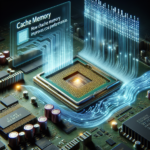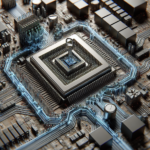The Role of CPU in Machine Learning and AI Applications
The Role of CPU in Machine Learning and AI Applications
Machine Learning (ML) and Artificial Intelligence (AI) have revolutionized various industries, from healthcare to finance, by enabling systems to learn from data and make intelligent decisions. While GPUs (Graphics Processing Units) often steal the spotlight for their parallel processing capabilities, CPUs (Central Processing Units) play a crucial role in the development, training, and deployment of ML and AI applications. This article delves into the multifaceted role of CPUs in these cutting-edge technologies.
Understanding the Basics: What is a CPU?
The CPU, often referred to as the “brain” of the computer, is responsible for executing instructions from programs. It performs basic arithmetic, logic, control, and input/output (I/O) operations specified by the instructions. Modern CPUs are highly sophisticated, featuring multiple cores, large caches, and advanced instruction sets that enable them to handle a wide range of tasks efficiently.
Key Components of a CPU
- Arithmetic Logic Unit (ALU): Performs arithmetic and logical operations.
- Control Unit (CU): Directs the operation of the processor.
- Cache: A small, fast memory located close to the CPU cores to speed up access to frequently used data.
- Cores: Individual processing units within the CPU that can execute instructions independently.
The Role of CPU in Machine Learning
While GPUs are often highlighted for their ability to handle parallel processing tasks efficiently, CPUs are indispensable in various stages of machine learning workflows. Below are some key areas where CPUs play a vital role:
Data Preprocessing
Before feeding data into a machine learning model, it must be cleaned, transformed, and normalized. These preprocessing steps often involve complex operations on large datasets, which can be efficiently handled by modern multi-core CPUs. Tasks such as data loading, feature extraction, and data augmentation are typically performed on CPUs.
Model Training
Although GPUs are preferred for training large-scale models due to their parallel processing capabilities, CPUs are still essential for training smaller models or for initial prototyping. Many machine learning frameworks, such as TensorFlow and PyTorch, offer CPU support, making it easier for developers to experiment with different models without the need for specialized hardware.
Hyperparameter Tuning
Hyperparameter tuning involves searching for the best set of parameters that optimize the performance of a machine learning model. This process often requires running multiple training sessions with different parameter combinations. CPUs are well-suited for this task, especially when combined with parallel processing techniques to evaluate multiple configurations simultaneously.
Model Inference
Once a model is trained, it is deployed to make predictions on new data, a process known as inference. CPUs are commonly used for inference in production environments due to their versatility and ability to handle diverse workloads. Many real-time applications, such as recommendation systems and fraud detection, rely on CPU-based inference to deliver quick and accurate results.
The Role of CPU in AI Applications
AI applications encompass a broad range of technologies, including natural language processing (NLP), computer vision, and robotics. CPUs play a critical role in enabling these applications by providing the necessary computational power and flexibility.
Natural Language Processing (NLP)
NLP involves the interaction between computers and human language, enabling machines to understand, interpret, and generate text. CPUs are instrumental in various NLP tasks, such as:
- Text Tokenization: Breaking down text into smaller units, such as words or sentences.
- Part-of-Speech Tagging: Identifying the grammatical categories of words.
- Named Entity Recognition (NER): Detecting and classifying entities, such as names and dates, within text.
These tasks often require complex algorithms and large datasets, making CPUs an ideal choice for their execution.
Computer Vision
Computer vision enables machines to interpret and understand visual information from the world. CPUs are essential for various computer vision tasks, including:
- Image Preprocessing: Enhancing and transforming images before feeding them into a model.
- Feature Extraction: Identifying important features within images, such as edges and textures.
- Object Detection: Locating and classifying objects within images or videos.
While GPUs are often used for training deep learning models in computer vision, CPUs are crucial for preprocessing and real-time inference tasks.
Robotics
Robotics involves the design, construction, and operation of robots that can perform tasks autonomously or semi-autonomously. CPUs are vital in robotics for several reasons:
- Control Systems: Managing the movement and actions of robots.
- Sensor Data Processing: Interpreting data from various sensors, such as cameras and LIDAR.
- Path Planning: Determining the optimal path for a robot to follow.
CPUs provide the necessary computational power and flexibility to handle these diverse tasks, enabling robots to operate efficiently in real-world environments.
Advantages of Using CPUs in ML and AI Applications
While GPUs are often preferred for their parallel processing capabilities, CPUs offer several advantages that make them indispensable in ML and AI applications:
Versatility
CPUs are designed to handle a wide range of tasks, making them suitable for various stages of the ML and AI workflow, from data preprocessing to model inference.
Cost-Effectiveness
CPUs are generally more affordable than specialized hardware, such as GPUs and TPUs (Tensor Processing Units). This makes them an attractive option for small-scale projects and initial prototyping.
Ease of Use
Many machine learning frameworks offer robust CPU support, making it easy for developers to get started without the need for specialized hardware. Additionally, CPUs are widely available in most computing environments, from personal laptops to cloud-based servers.
Energy Efficiency
CPUs are often more energy-efficient than GPUs, making them a better choice for applications where power consumption is a concern, such as edge computing and mobile devices.
Challenges and Limitations
Despite their advantages, CPUs also have some limitations that can impact their performance in ML and AI applications:
Limited Parallel Processing
CPUs are not as efficient as GPUs in handling parallel processing tasks, which can be a bottleneck when training large-scale models or processing massive datasets.
Memory Bandwidth
CPUs typically have lower memory bandwidth compared to GPUs, which can limit their ability to handle data-intensive tasks efficiently.
Scalability
While CPUs can handle a wide range of tasks, they may struggle to scale up for large-scale ML and AI applications that require significant computational power.
Future Trends and Developments
The role of CPUs in ML and AI applications is continually evolving, driven by advancements in hardware and software technologies. Some emerging trends and developments include:
Specialized Instruction Sets
Modern CPUs are incorporating specialized instruction sets, such as Intel’s AVX-512 and AMD’s Ryzen AI, to accelerate ML and AI workloads. These instruction sets enable CPUs to perform complex operations more efficiently, reducing the gap between CPU and GPU performance.
Hybrid Architectures
Hybrid architectures that combine CPUs with other specialized hardware, such as GPUs and FPGAs (Field-Programmable Gate Arrays), are becoming increasingly popular. These architectures leverage the strengths of each component to deliver optimal performance for ML and AI applications.
Edge Computing
The rise of edge computing is driving the development of energy-efficient CPUs designed for low-power devices. These CPUs enable ML and AI applications to run directly on edge devices, reducing latency and improving real-time decision-making capabilities.
FAQ
Can I use a CPU for training large-scale machine learning models?
While it is possible to use a CPU for training large-scale machine learning models, it may not be the most efficient option. GPUs are generally preferred for training large models due to their parallel processing capabilities. However, CPUs can still be useful for initial prototyping and training smaller models.
What are the advantages of using a CPU for inference in AI applications?
CPUs offer several advantages for inference in AI applications, including versatility, cost-effectiveness, ease of use, and energy efficiency. They are well-suited for real-time applications that require quick and accurate predictions.
How do modern CPUs handle parallel processing tasks?
Modern CPUs feature multiple cores and advanced instruction sets that enable them to handle parallel processing tasks more efficiently. While they may not match the parallel processing capabilities of GPUs, they can still perform well for many ML and AI workloads.
Are there any specific machine learning frameworks optimized for CPUs?
Many popular machine learning frameworks, such as TensorFlow, PyTorch, and scikit-learn, offer robust CPU support. These frameworks are optimized to take advantage of modern CPU architectures and instruction sets, making it easier for developers to build and deploy ML models on CPUs.
What is the role of CPUs in edge computing for AI applications?
In edge computing, CPUs play a crucial role in enabling AI applications to run directly on edge devices. Energy-efficient CPUs designed for low-power devices can handle various ML and AI tasks, reducing latency and improving real-time decision-making capabilities.
Conclusion
While GPUs often dominate the conversation around machine learning and AI due to their parallel processing prowess, CPUs remain an essential component in these fields. From data preprocessing and model training to hyperparameter tuning and inference, CPUs offer versatility, cost-effectiveness, and ease of use. As hardware and software technologies continue to evolve, the role of CPUs in ML and AI applications will only grow, driven by advancements in specialized instruction sets, hybrid architectures, and edge computing. Understanding the strengths and limitations of CPUs can help developers make informed decisions when building and deploying ML and AI solutions.




